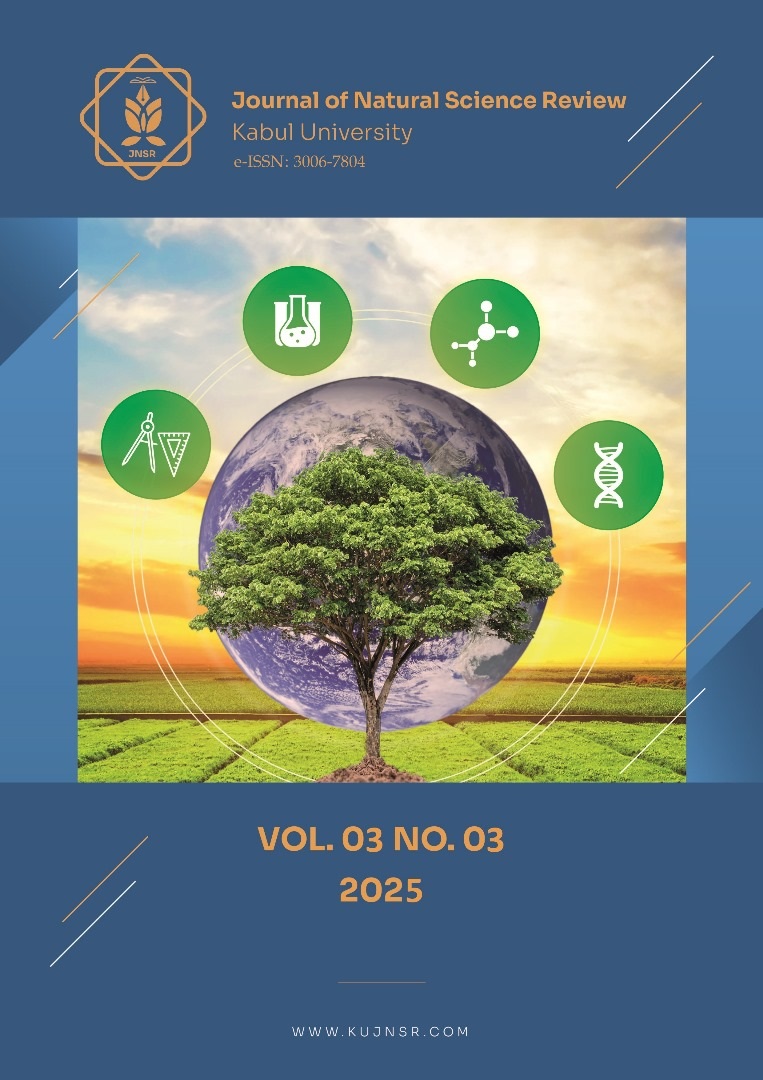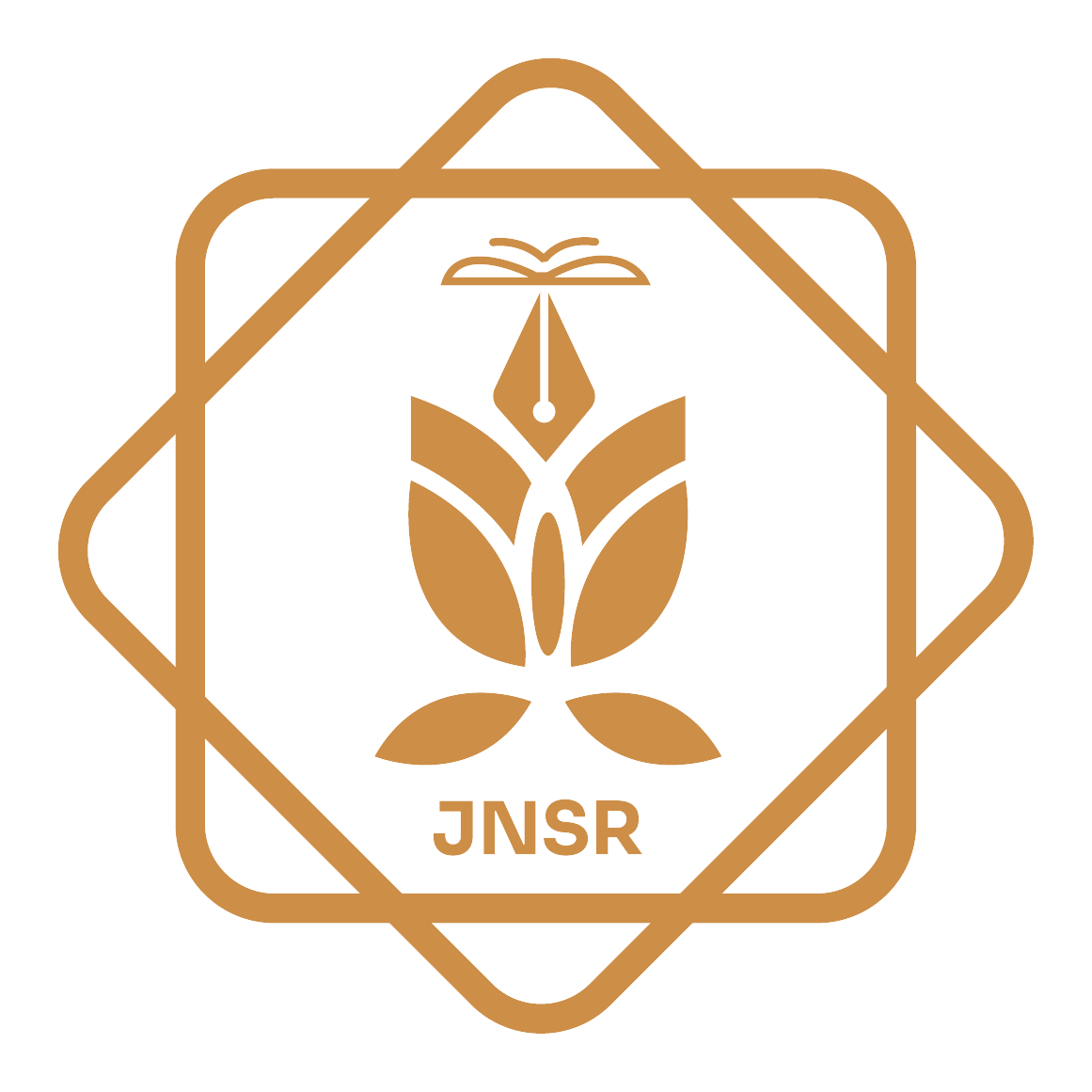Effects of Humic Acid Applications on Growth and Yield of Garlic (Allium sativum L.) in Kandahar, Afghanistan
DOI:
https://doi.org/10.62810/jnsr.v3i3.280Keywords:
Allium sativum, Garlic, Growth, Humic Acid, YieldAbstract
Garlic (Allium sativum L.) is one of the most important vegetable crops and a common culinary spice used daily by most people around the world. Humic acid can enhance garlic growth and yield, and previous studies have reported that its application improves these traits. Although the effects of humic acid combined with other nutrients on the growth and quality of garlic have been studied, further comprehensive investigations are still needed, especially in Afghanistan's bioclimatic conditions. Therefore, the study aimed to examine the effects of humic acid on the growth and yield of garlic. The specific objective of the study was to determine the optimal amount of humic acid for promoting the growth and yield of garlic in Kandahar. A filed experiment was conducted at the research farm of Afghanistan National Agricultural Sciences and Technology University (ANASTU), using Randomized Complete Block Desing (RCBD) with five treatments T0 (no Humic acid), T1 (10 Kg ha-1 Humic acid), T2(15 Kg ha-1 Humic acid), T3 (20 Kg ha-1 Humic acid), and T4 (25 Kg ha-1 Humic acid) each replicated trice. The results showed that plant height, No. Leaves of plant-1, and leaves length increased significantly by 30.40%, 28.21%, and 19.97% respectively, compared to the control at harvest; moreover, Bulb weight, bulb polar diameter, bulb equatorial diameter, No. Of cloves bulb-1, cloves weight, cloves length, clove diameter, and bulb yield also significantly increased by 68.79%, 59.42%, 20.72%, 17.38%, 26.50%, 36.36%, 47.28%, 71.09 %, respectively, in comparison to the control. It is concluded that the highest growth and yield of garlic was recorded in the treatment where 25 kg ha-1 Humic acid was applied.
Downloads
References
Abayaty, A. J. A. (2019). Effect of Addition Method of Organic Fertilizer (Humic Acid) on Growth, Yield and Active Ingredients of Allium sativum L. Journal of University of Garmian, Special, 153–159. https://doi.org/10.24271/garmian.scpas20 DOI: https://doi.org/10.24271/garmian.scpas20
Abdelkader, A. (2019). Effect of different levels of farmyard manure, mineral fertilization and potassium humate on growth and productivity of garlic. Middle East Journal of Applied Sciences, 9(2), 287–296. Link
Akpan, E. A., Akata, O. R., Essien, O. A., & Ben, F. E. (2025). Effect of Organic Fertilizers on Growth and Yield of Garlic ( Allium sativum L .) in Obio Akpa , Akwa Ibom State , Nigeria. Asian Research Journal of Agriculture, 18(1), 61–69. https://doi.org/10.9734/arja/2025/v18i1644 DOI: https://doi.org/10.9734/arja/2025/v18i1644
Al-Mharib, M. Z. K., Al-Zaidi, A. K. N., & Al-Quraishi, I. A. A. (2025). Effect of Adding Humic Acid and Potassium Fertilizer on Growth and Yield of Garlic Plants. IOP Conference Series: Earth and Environmental Science, 1487(1). https://doi.org/10.1088/1755-1315/1487/1/012037 DOI: https://doi.org/10.1088/1755-1315/1487/1/012037
Al-obeidi, M. M. H., & Al-obeidi, H. S. H. (2023). Effect of Organic Fertilizer Spraying from Various Sources and Agricultural Sulfur in the Growth and Harvest of Garlic. IOP Conference. Series, 1158(042067), 1–7. https://doi.org/10.1088/1755-1315/1158/4/042067 DOI: https://doi.org/10.1088/1755-1315/1158/4/042067
Attememe. J. Y. A. (2009). The effect of humic acid and sea weed extracts on the growth, chemical characteristics and oil characteristics of Rosmarinus officinalis L. The 6th scientific conference, Biology Dept., College of Education , University of Tikrit. Plants Sci. P. 1-17. Link
Ghasemi, K., Akbarpou, V., & Mohammadi, M. (2020). Morphological and phytochemical response of garlic ( Allium sativum ) to sulphur , humic acid and vermiwash nutrition. Journal of Horticultural Plants Nutrition, 3(1), 22–36. https://doi.org/10.22070/hpn.2020.4573.1032
Hassan Yousif, K. (2019). Effects of Humic acid and Sea Wedds extracts on Grwoth, Yield and Nutreint Content of Garlic (Allium sativum L.). Journal of University of Duhok, 21(1), 8–18. Link DOI: https://doi.org/10.26682/avuod.2019.21.1.2
Kumar G, N., AH, H., Y, P., Patil, S., A, A., & N, U. (2024). Effect of nutrients (Secondary and micronutrients) and humic acid on growth and bulb yield of garlic (Allium sativum L.). International Journal of Advanced Biochemistry Research, 8(8), 1258–1262. https://doi.org/10.33545/2618060x.2024.v7.i8sj.1357 DOI: https://doi.org/10.33545/26174693.2024.v8.i8p.2030
Mohammadi, M., Moghaddam, A., & Ghasemi, S. (2024). Effect of Salicylic Acid and Humic Acid on the Yield and Antioxidant Activity of Garlic. Plant Production Technology, 23(2), 29–37. https://doi.org/10.22084//PPT.2024.17359.1876
Petropoulos, S. A., Fernandes, Â., Ntatsi, G., Petrotos, K., Barros, L., & Ferreira, I. C. F. R. (2018). Nutritional Value, Chemical Characterization and Bulb Morphology of Greek Garlic Landraces. Molecules, 23(1319), 1–14. https://doi.org/10.3390/molecules23020319 DOI: https://doi.org/10.3390/molecules23020319
Rathor, P., Gorim, L. Y., Chen, G., & Thilakarathna, M. S. (2025). The Effect of Humalite on Improving Soil Nitrogen Availability and Plant Nutrient Uptake for Higher Yield and Oil Content in Canola. Physiologia Plantarum, 177(2), 1–16. https://doi.org/10.1111/ppl.70201 DOI: https://doi.org/10.1111/ppl.70201
Salihi, M. S., Hamim, H., & Serat, S. M. (2024). Impacts of Humic Acid on Growth and Yield of Wheat A Review. Journal of Natural Science Review, 2(3), 87–96. DOI: https://doi.org/10.62810/jnsr.v2i3.81 DOI: https://doi.org/10.62810/jnsr.v2i3.81
Sunanta, P., Kontogiorgos, V., Pankasemsuk, T., Jantanasakulwong, K., Rachtanapun, P., Seesuriyachan, P., & Sommano, S. R. (2023). The nutritional value, bioactive availability and functional properties of garlic and its related products during processing. Frontiers in Nutrition, 10(1142784), 1–13. https://doi.org/10.3389/fnut.2023.1142784 DOI: https://doi.org/10.3389/fnut.2023.1142784
Vioratti, O., Moura, T. De, Luiz, R., Berbara, L., França, D., Torchia, D. O., Fernanda, H., Da, O., Augusto, T., Castro, V. T. De, Carlos, O., Tavares, H., Rodrigues, N. F., Zonta, E., Santos, L. A., & García, A. C. (2023). Humic foliar application as sustainable technology for improving the growth, yield, and abiotic stress protection of agricultural crops. A review. Journal of the Saudi Society of Agricultural Sciences, 22(8), 493–513. https://doi.org/10.1016/j.jssas.2023.05. DOI: https://doi.org/10.1016/j.jssas.2023.05.001
Yang, F., & Antonietti, M. (2020). Artificial humic acids: sustainable materials against climate change. Advanced Science, 7(5), 1902992. https://doi.org doi/ 10.1002/advs.201902992 DOI: https://doi.org/10.1002/advs.201902992
Zheng, E., Qin, M., Zhang, Z., & Xu, T. (2022). Humic Acid Fertilizer Incorporation Increases Rice Radiation Use, Growth, and Yield: A Case Study on the Songnen Plain, China. Agricullture, 12(653), 1–13. https://doi.org/10.3390/agriculture12050653 DOI: https://doi.org/10.3390/agriculture12050653
Downloads
Published
How to Cite
Issue
Section
License
Copyright (c) 2025 Mirwais Khan Afghan, Rahimullah Himatkhwah, MOHAMMAD SADIQ SALIHI

This work is licensed under a Creative Commons Attribution-NonCommercial 4.0 International License.



























